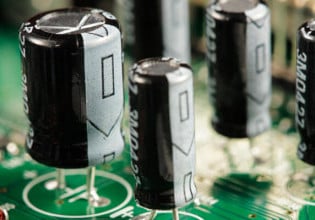How Lightweight 5G is Made Possible by GaN
With the launch of 5G, this next generation cellular network promises a trilogy of capabilities that will change how we approach wireless applications. Offering massive connectivity, tremendous throughput, and ultra-low latency, many applications will, at last, be able to ditch the wire.
While businesses and consumers await rollout in their regions to benefit from 5G, network operators must carefully assess how to install the required hardware. Today’s equipment often uses rented sites and properties with strict limits set on floor area, volume, and allowable weight. Furthermore, 5G makes use of additional equipment compared to 4G, such as active antenna systems (AAS) and micro base transceiver stations (BTS), to implement the coverage needed for massive connectivity (Figure 1). Available power at such sites can be limited too, restricting what can be installed. Since rental costs make up around one-third of the operating expense (OPEX) outlay, 5G systems need to do more than the 4G systems they replace while being the same or lighter in weight and smaller in volume.

Figure 1. Massive connectivity requires small cell BTS and active antenna systems, all of which have demanding power requirements. Image used courtesy of Bodo’s Power Systems
Power switching from silicon to GaN
Gallium nitride (GaN) wide-bandgap transistors are already contributing to the radio-side of 5G, but they are increasingly being considered for the power supplies too. Its superior performance when compared to silicon MOSFETs translates to improved efficiency, leading to reduced heat dissipation, smaller, more compact designs, and improved robustness. Telecom operators benefit by consuming less energy and needing fewer on-site visits to service and repair equipment.
Relatively temperature-independent RDS(ON) coupled with almost no reverse recovery charge (Qrr) mean that GaN high-electron-mobility transistors (HEMT) are suited to both power factor correction (PFC) and DC-DC converter stages. Thanks to the higher switching frequencies supported, smaller passives can also be used, delivering designs that are both compact and lighter in weight than silicon-based alternatives. A move to natural convection, instead of forced-air cooling, can often be considered too.
Power converters based upon silicon MOSFETs, such as the 80 V OptiMOS™ 5 series, are a staple of 1 kW 48 V to 12 V DC-DC ¼ brick designs, delivering peak efficiencies of 97.58 %. By moving such a design to CoolGaN™, the same 1 kW LLC solution achieved a 5 % reduction in heat and peak efficiency of 97.70 % (Figure 2). The efficiency improvement achieved at light loads can be attributed to the move to GaN. Conduction losses are the primarily contributor at full load, so the move to GaN has little impact on efficiency at the highest current consumption.


Figure 2. Efficiency comparison of a 1 kW fixed-frequency 48 V to 12 V ¼ brick DC-DC LLC when using silicon MOSFETs and CoolGaN™. Image used courtesy of Bodo’s Power Systems
Replacing silicon MOSFETs with CoolGaN™ in a 3.6 kW, 385 V to 52 V DC-DC LLC delivers even more significant improvements, even when the PFC is already GaN-based. By moving the two synchronous rectifier stages to GaN, heat dissipation was reduced by some 15 %. Despite both devices exhibiting similar RDS(ON) values, the supply attained a peak efficiency of 97.83 % in this 160 W/inch3 design (Figure 3). Subtracting the impact of the housekeeping supply and cooling fan, the peak efficiency almost touches 98.5 %.
Gate drivers and packaging
The benefits of moving from silicon to GaN can be further improved with an optimized gate driver IC. Infineon’s new 1EDN71x6x EiceDRIVER™ family helps designers to achieve the lowest switching loss and fastest switching transitions for CoolGaN™ Schottky Gate HEMTs, without suffering excessive ringing or spurious switching. Key features include an active Miller clamp and optional negative charge pump to avoid Miller-induced turn-on events, bootstrap voltage clamping, and truly differential input with high common-mode transient immunity. Four driving strengths are available, enabling designers to optimize the switching speed for each GaN SG HEMT without adding gate resistors.


Figure 3. Efficiency comparison of CoolGaN™ in a 3.6 kW DC-DC LLC versus silicon MOSFETs. Image used courtesy of Bodo’s Power Systems
New power supply housings and innovation in heat extraction are also needed to reduce equipment weight and provide alternative installation approaches, such as in street lighting, that are aesthetically pleasing. CoolGaN™ supports this thanks to its low inductance, low-profile PG-VSON surface mount packaging (Figure 4). Measuring just 5 × 3 × 1.075 mm, not only does it help with passive heat dissipation approaches in narrow, low-profile, and rack-mounted designs, it also helps to keep traces short and their inductance low.

Figure 4. The PG-VSON surface mount package of the medium voltage CoolGaN™ device*, with its low inductance leakage, is ideal for high-frequency switching applications. Image used courtesy of Bodo’s Power Systems
GaNs’ broader impact on 5G
Due to its performance at high frequencies, GaN is often linked with the implementation of 5G RF transceivers. However, due to the pressures on equipment volume and weight caused by the cost of site rental and physical restrictions, it is also exceptionally relevant for base station power supplies. Infineon’s portfolio of CoolGaN™ HEMT transistors, ably supported by matching EiceDRIVER™s, ensure these design goals for 5G can also be met while also improving efficiency and reliability.
This article originally appeared in Bodo’s Power Systems magazine.






